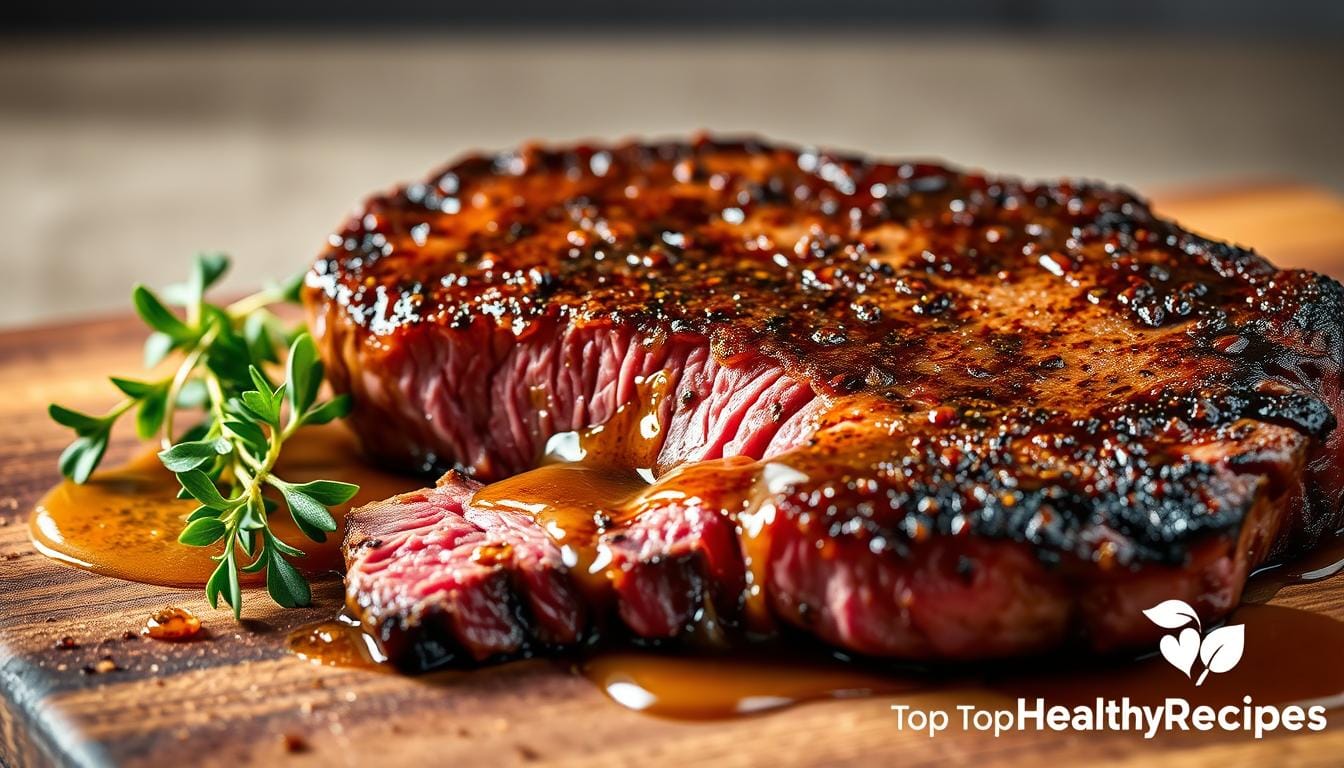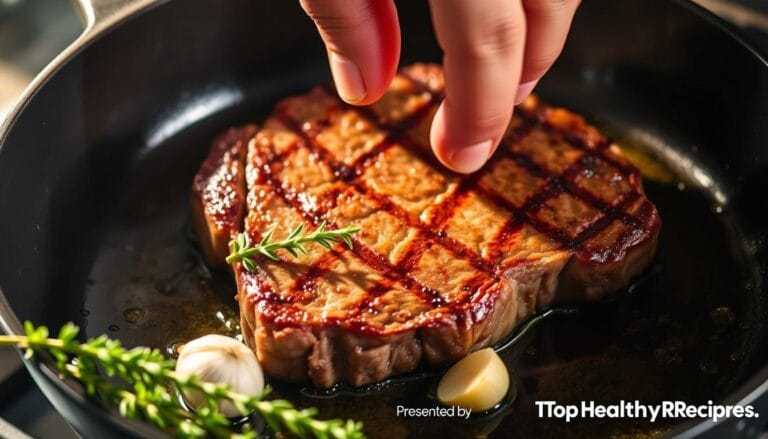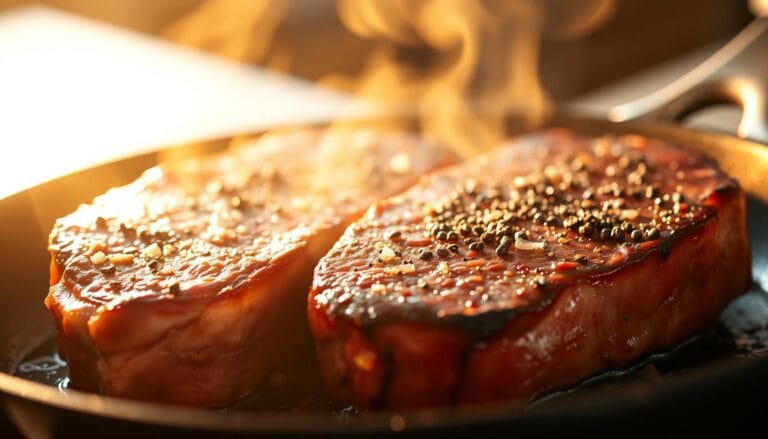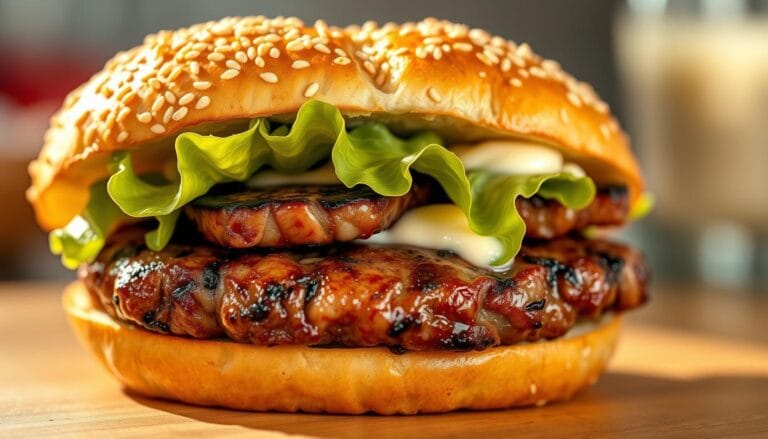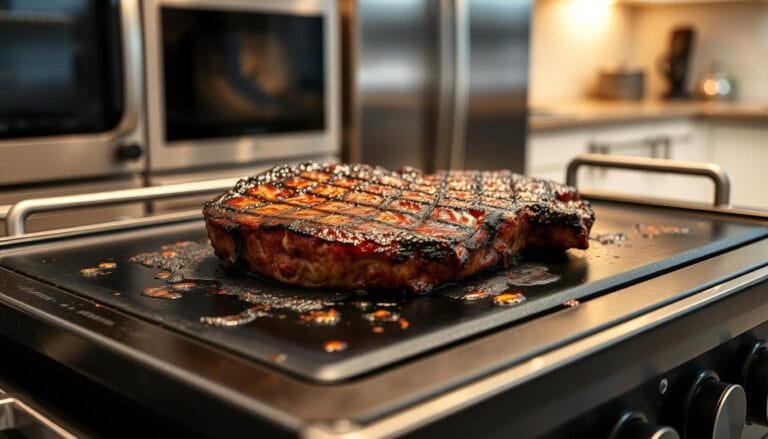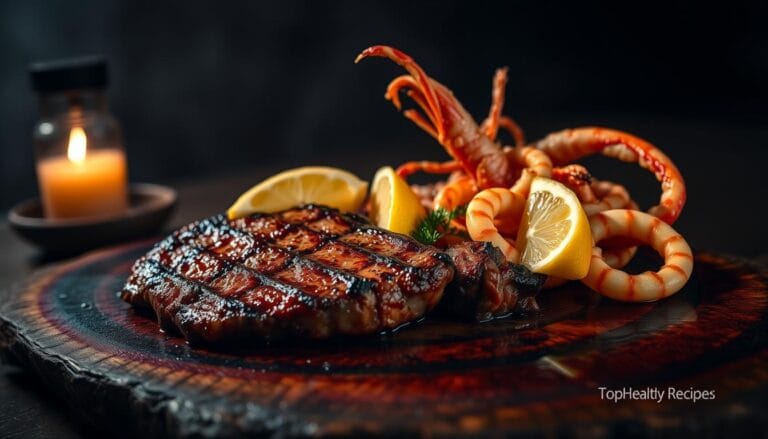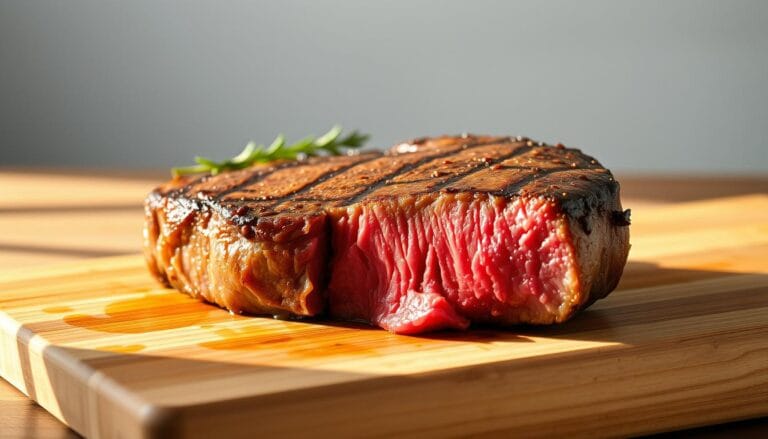New York Strip in Oven: A Foolproof Way to Tender, Flavorful Steak
Table of Contents
New York Strip in Oven: A Foolproof Way to Tender, Flavorful Steak
Do you remember the last time you grilled a steak and it didn’t turn out right? You’re not alone. I used to struggle with uneven charring and a dry center. But then I found out a secret chefs use every day: your oven is the ultimate steak-cooking ally.
Oven roasting is different from outdoor grilling. It gives you control over the heat. This method keeps the juices in and creates a delicious crust with a simple reverse-sear technique. Imagine a steak that’s perfectly pink all the way through, with a crispy outside that sounds like a crackle when you cut it. That’s what happens when you master this method.
After many tries, I figured out why oven cooking beats traditional methods. The dry heat cooks the steak evenly, bringing out the flavors without overcooking. You won’t have to worry about flames or guessing the steak’s temperature. Consistency becomes your default setting – whether it’s for a special dinner or a family gathering.
Key Takeaways
- Oven cooking eliminates guesswork for uniform doneness
- Reverse searing creates superior texture and moisture retention
- Controlled heat prevents flare-ups and burnt exteriors
- Restaurant-quality results require minimal equipment
- Perfect for all weather conditions and kitchen setups
Understanding the New York Strip Steak
Before you start cooking, it’s good to know why the New York Strip is so great. It comes from the short loin’s longissimus muscle. This area is naturally tender and has just the right amount of fat for flavor.
What Makes NY Strip Special?
Chefs love the longissimus muscle for its perfect mix of tenderness and flavor. Unlike other cuts, the NY Strip’s marbling melts during cooking. This adds extra flavor to the steak.
A Texas butcher once said:
“A well-marbled NY Strip is like nature’s self-basting roast – it practically cooks itself right.”
USDA grading helps find the best quality:
| Grade | Marbling Level | Best For |
|---|---|---|
| Prime | Abundant | Special occasions |
| Choice | Moderate | Everyday cooking |
| Select | Minimal | Marinade-heavy dishes |
Characteristics of a Quality Cut
Here’s what to look for in a New York Strip steak:
- 1/4″ fat cap: Keeps meat moist during cooking
- 1.5″ thickness: Helps avoid overcooking
- Bright red color: Shows it’s fresh
Nutritional Profile of New York Strip
A 6-oz serving has:
| Nutrient | Amount | Daily Value% |
|---|---|---|
| Protein | 48g | 96% |
| Iron | 3.6mg | 20% |
| Zinc | 8.2mg | 55% |
It has more saturated fat than chicken or fish. But, it’s high in protein, making it good for low-carb diets in moderation.
Preparing Your New York Strip
A perfectly cooked New York Strip starts with two key steps: choosing the right steak and using the right tools. Getting these right ensures your steak cooks evenly, develops a flavorful crust, and stays juicy. Let’s explore how to set yourself up for success before you even turn on the oven.
Choosing the Right Steak
Start at the meat counter with these visual checks:
- Marbling matters: Look for thin white fat streaks throughout the meat – this melts during cooking for extra flavor
- Color tells freshness: Bright cherry-red indicates quality; avoid grayish or brown spots
- Fat cap check: A ¼-inch outer fat layer adds flavor without being excessive
Thickness is key for oven cooking. Choose 1-1.5-inch cuts. Thinner steaks dry out quickly, while thicker ones need longer cook times. Butcher counters often label these as “oven-ready” or “roast cuts.”
Essential Tools for Preparation
These four items make steak prep easy:
| Tool | Purpose | Why It Matters |
|---|---|---|
| Cast-iron skillet | Searing & oven transfer | Retains heat for perfect crust-to-oven transition |
| Instant-read thermometer | Checking doneness | Prevents overcooking (aim for 130°F for medium-rare) |
| Stainless steel tongs | Handling hot steak | Won’t pierce meat like forks, keeping juices intact |
| Carving board with groove | Resting & slicing | Channels juices away from steak surface |
Pro tip: Leave your steak uncovered in the fridge for 1 hour before cooking. This air-dries the surface, helping you achieve that restaurant-quality sear. Pair these prep steps with proper seasoning for steakhouse results at home.
Seasoning the Steak
Mastering seasoning techniques is key to unlocking your New York Strip’s full flavor. The right mix of flavors brings out the steak’s natural richness without overwhelming its texture. Let’s explore the essentials for a flavorful crust.
Classic Seasonings for NY Strip
Keep it simple – a quality cut needs minimal interference. Start with kosher salt and freshly cracked black pepper. Add garlic powder or smoked paprika for depth. Fresh rosemary or thyme leaves add a fragrant touch when pressed into the meat.
Match your spices with cooking methods using this flavor matrix:
| Cooking Method | Best Spices | Flavor Impact |
|---|---|---|
| Oven-Roasting | Rosemary + Garlic | Herbaceous warmth |
| Reverse Sear | Coarse Pepper + Coriander | Bold, spicy crust |
| High-Heat Bake | Smoked Paprika + Mustard Powder | Smoky tang |
Marinades: Do You Need Them?
Marinades are great for tougher cuts, but not for New York Strip. Its marbling makes it tender. Acidic marinades can break down the fat. Try these fresh alternatives instead:
- Chimichurri drizzle post-cooking
- Compound butter melting over rested steak
- Salsa verde for bright contrast
Tips for Salt Timing
Salt timing is critical for your New York Strip steak. Dry brining (salting 1-4 hours before cooking) enhances the crust. For quick prep, salt right before searing. Avoid salting 15 minutes before to prevent losing juices.
Follow this salt timeline for best results:
- 4+ hours before: Salt and refrigerate uncovered
- 40 minutes before: Salt at room temperature
- Right before cooking: Pat dry and season
Cooking Techniques for New York Strip
To master your New York strip steak, pick the right cooking method. Oven-baking is great for even results, but stovetop searing has its perks. Here are three reliable ways to cook a steakhouse-quality steak at home.
Oven-Baking vs. Other Methods
Oven-baking is perfect for thicker cuts because it cooks evenly. It’s a hands-off method that prevents overcooking. But, if you’re in a hurry, stovetop searing can give you a better crust.
| Method | Heat Control | Crust Formation | Ideal Thickness |
|---|---|---|---|
| Oven-Baking | Consistent | Moderate | 1.5″+ |
| Stovetop Searing | High & Fast | Excellent | 1″-1.25″ |
| Reverse Sear | Low then High | Exceptional | 1.75″+ |
Reverse Sear Method Explained
The reverse sear method ensures a perfect medium-rare steak with a crispy crust. First, cook the steak in a 250°F oven until it’s 15°F below your desired temperature. Then, sear it in a hot skillet for 90 seconds. This method offers:
- Even internal doneness
- Less chance of overcooking
- Better fat rendering in thicker cuts
One-Pan Cooking for Easy Cleanup
Use an oven-safe skillet like cast iron for searing and baking. Brown the steak on the stovetop, then bake it in a 400°F oven. This method is great for easy cleanup. A pro tip: deglaze the pan with red wine for a quick sauce.
Oven Temperature and Cooking Times
Mastering New York strip steak in the oven is all about heat and timing. Your oven cooks the meat gently, keeping its juices in. We’ll explore how to get your steak just right without any guesswork.
Finding the Sweet Spot for Heat
400°F is the best oven temperature for NY strip. It creates a tasty crust and cooks evenly. For a quick sear before oven cooking, start with a hot pan.
For methods like pan-to-oven, preheat your oven 10 minutes early. This ensures a smooth transition.
Timing Based on Thickness
Thicker steaks need more time. Here’s a table for 400°F oven settings:
| Thickness | Target Doneness | Approx. Time |
|---|---|---|
| 1 inch | Medium-Rare | 10-12 minutes |
| 1.5 inches | Medium | 14-16 minutes |
| 2 inches | Well-Done | 18-20 minutes |
These times include carryover cooking, where the steak’s temperature rises after it’s removed. Aim to pull your steak 5° before your desired doneness to avoid overcooking.
The Thermometer Advantage
Digital meat thermometers make cooking easier. Insert the probe into the thickest part, avoiding bone or fat. Use these guidelines:
- Rare: 120-125°F (remove at 115°F)
- Medium-Rare: 130-135°F (remove at 125°F)
- Well-Done: 150-160°F (remove at 145°F)
Pro tip: For pan-to-oven cooking, sear the steak 2 minutes per side on high heat. Then, move it to the oven. This method is like a restaurant’s, but keeps your kitchen clean.
Resting Your Steak
You’ve got the oven temperature and cooking time down. Now, the make-or-break step is resting your New York strip. It’s not just a step; it’s what turns good steak into amazing.
Why Resting is Important
When you take the steak out of the oven, its fibers are tight. Resting lets them relax and soak up juices. Don’t skip this, or you’ll lose those juices.
Proteins in the meat tighten up with heat, pushing out moisture. A 5-10 minute rest lets juices spread out, adding flavor. It also helps the meat cook a bit more, reaching perfect doneness.
“Resting is like letting a good story breathe—it makes the ending worth waiting for.”
How Long to Let Your Steak Rest
Steak thickness determines rest time. Here’s a simple guide:
| Steak Thickness | Minimum Rest Time | Ideal Rest Time |
|---|---|---|
| 1 inch | 5 minutes | 7-8 minutes |
| 1.5 inches | 8 minutes | 10 minutes |
| 2 inches | 10 minutes | 12-15 minutes |
For a crispy crust from reverse searing, resting is key. Place your steak on a warm plate and cover loosely with foil. Avoid tight wrapping to keep the crust crispy.
Sides to Complement Your New York Strip
A perfectly cooked New York strip steak needs sides that make its flavor shine. Whether it’s for a dinner party or a weeknight meal, these sides and wines will make your new york strip steak recipe unforgettable.
Classic Sides That Pair Well
Traditional sides balance the steak’s boldness with creamy or earthy flavors. Try these timeless pairings:
- Garlic mashed potatoes (25-minute prep): Use Yukon Gold potatoes for extra creaminess
- Creamed spinach (15-minute cook time): Add nutmeg for depth
- Roasted mushrooms (20-minute roast): Mix cremini and shiitake varieties
Quick and Easy Side Dishes
Short on time? These easy options pack a lot of flavor:
- Balsamic-glazed asparagus (12-minute roast)
- Parmesan-crusted zucchini (10-minute air fry)
- Pre-washed arugula salad (5-minute assembly) with lemon vinaigrette
Wine Pairing Suggestions
Sommeliers suggest these reds to match the steak’s marbling:
- Cabernet Sauvignon: Bold tannins cut through the fat
- Malbec: Plum notes enhance the steak’s natural sweetness
- Zinfandel (for spicy rubs): Jammy flavors balance heat
Pro tip: Let wine breathe 30 minutes before serving for optimal flavor.
Common Mistakes to Avoid
Getting your New York strip steak just right takes focus. Even small mistakes can make a great cut tough. Let’s look at three common errors and how to avoid them. We’ll also share tips for home cooks.
Overcooking Your New York Strip
Steak doneness can sneak up quickly in the oven, even with thinner cuts. Use a meat thermometer for exactness: take the steak out 5°F before your target temperature. It will heat up a bit while it rests. For a visual check, look for these signs:
| Doneness Level | Internal Temp | Visual/Tactile Clues |
|---|---|---|
| Medium-Rare | 130-135°F | Springy center, bright pink interior |
| Medium | 135-145°F | Firmer texture, light pink middle |
| Well-Done | 155°F+ | No pink, very firm to touch |
Don’t press down on the steak with spatulas. This can push out juices. If your oven cooks too fast, cook it 2-3 minutes less per inch of thickness.
Skipping the Resting Stage
Resting is a must. Juices need 5-7 minutes to spread out after cooking. Cutting too soon leads to:
- Pooled juices on the plate
- Dry, stringy texture
- Uneven temperature
Use foil to cover loosely during resting. But don’t wrap it too tight, or you’ll steam the crust. For thicker steaks (1.5”+), rest for 10 minutes.
Ignoring Your Oven’s Hot Spots
Ovens don’t heat evenly. Gas ovens have stronger heat at the bottom, while electric ones can have hot spots near the walls. Test your oven:
- Place bread slices on a baking sheet
- Bake at 350°F for 5 minutes
- Check which slices brown fastest
If your steak is cooking too fast, turn the pan halfway through. For broiling, place the steak 6-8” below the heating element to avoid charring.
Enhancing Flavor After Cooking
Your perfectly cooked New York Strip deserves a grand finale. These post-cooking techniques transform good steak into a restaurant-worthy masterpiece. They let you repurpose stovetop cooking elements. Focus on texture, aroma, and visual appeal to create an unforgettable meal.
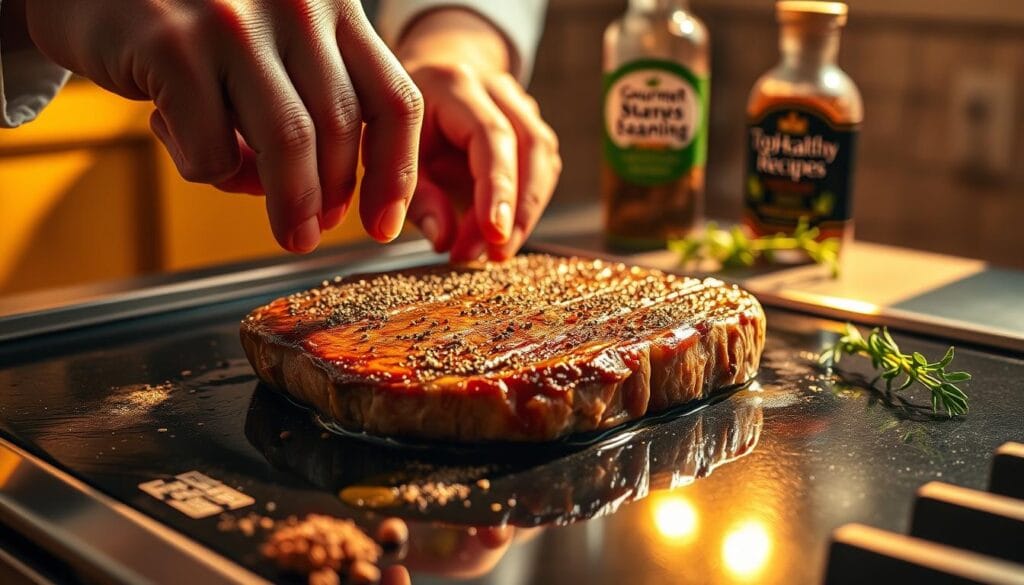
Finishing Touches to Elevate Taste
Compound butters melt into the steak’s surface, adding richness and moisture. Try mixing softened butter with:
- Roasted garlic and rosemary
- Lemon zest and cracked pepper
- Smoked paprika and thyme
For stovetop cooking, drizzle herb-infused oils using the same pan. Heat olive oil with fresh herbs like sage or tarragon for 2 minutes, then strain.
Sauces and Toppings to Consider
Use the fond (browned bits) from your skillet to make quick pan sauces. Deglaze with these liquids:
| Sauce Type | Key Ingredients | Best For |
|---|---|---|
| Red Wine Pan Sauce | Shallots, red wine, beef broth | Classic flavor pairing |
| Garlic Herb Butter | Butter, garlic, parsley | Quick weeknight meals |
| Mushroom Cream | Cremini mushrooms, cream, thyme | Luxurious texture |
Garnishing Your Plate
Presentation matters as much as taste. Arrange steak diagonally on warm plates, topping with:
- Microgreens or edible flowers
- Crispy fried onions
- Flaky sea salt crystals
When learning how to cook strip steak on stove, remember that drippings can be reused. Brush reduced pan juices over sliced meat for extra shine.
Storing Leftover New York Strip
Proper storage turns leftover steak into a tasty meal the next day. It keeps the food safe and the flavors intact. Whether you’re saving it for later or keeping it rare, these tips help.
Best Practices for Refrigeration
Cool your steak to room temperature within 2 hours of cooking (1 hour if it’s hot). Slice it against the grain to reduce moisture loss. Here are some top methods:
| Storage Method | Max Duration | Key Benefit |
|---|---|---|
| Airtight Container | 3-4 Days | Prevents odor transfer |
| Vacuum Sealing | 2-3 Weeks | Blocks freezer burn |
| Butcher Paper Wrap | 2 Days | Maintains crust texture |
The USDA says keep refrigerated meats at 40°F or below. Freeze portions in vacuum-sealed bags for longer storage. Thaw frozen steak in the fridge overnight before reheating.
Reheating Without Losing Flavor
Use pan-reheating to bring back your NY strip’s crust. Follow this for top-notch results:
- Heat cast iron skillet over medium-low
- Add 1 tsp butter or beef tallow
- Warm steak 90 seconds per side
- Rest 3 minutes before serving
For medium-rare, aim for 130°F with a meat thermometer. Don’t microwave it – it gets tough. Serve with fresh sides like arugula salad for a nice contrast.
Variations on the Classic Recipe
Once you’ve mastered the basics, transform your New York strip into a global culinary adventure. These creative twists let you explore bold flavors while maintaining the steak’s signature tenderness.
Herb-Infused NY Strip
Elevate your steak with fresh herbs that complement beef’s natural richness. Mix 3 tbsp chopped rosemary, 2 tbsp thyme leaves, and 1/4 cup olive oil for a Mediterranean rub. Apply this mixture 45 minutes before cooking to let flavors penetrate.
- Best herb pairings: Sage + garlic | Oregano + lemon zest | Tarragon + Dijon
- Pro tip: Crush herbs with coarse salt to release essential oils
Peppercorn-Crusted NY Strip
Create a spicy exterior crust using mixed peppercorns. Crush 2 tbsp rainbow peppercorns coarsely and press into the steak’s surface. For better adhesion:
- Pat steak dry with paper towels
- Brush with thin mayo layer (trust us!)
- Press peppercorns firmly into all sides
Asian-Inspired Marinade Ideas
Fermented ingredients add complex umami notes to your New York strip. Try these bold combinations:
| Marinade Type | Key Ingredients | Marinating Time |
|---|---|---|
| Gochujang Glaze | 3 tbsp gochujang, 1 tbsp rice vinegar, 1 tsp sesame oil | 2-4 hours |
| Miso Magic | White miso paste, mirin, grated ginger | 6-8 hours |
For quick weeknight meals, use ponzu sauce as a 30-minute marinade. The citrusy notes pair perfectly with beef’s richness without overwhelming it.
Cooking for a Crowd: Scaling Up
When you’re cooking for a big group, making sure all the New York strip steaks are cooked just right is key. Whether it’s a holiday feast or a BBQ, baking the steaks in the oven is a smart move. It makes cooking for many easier without losing flavor or texture.
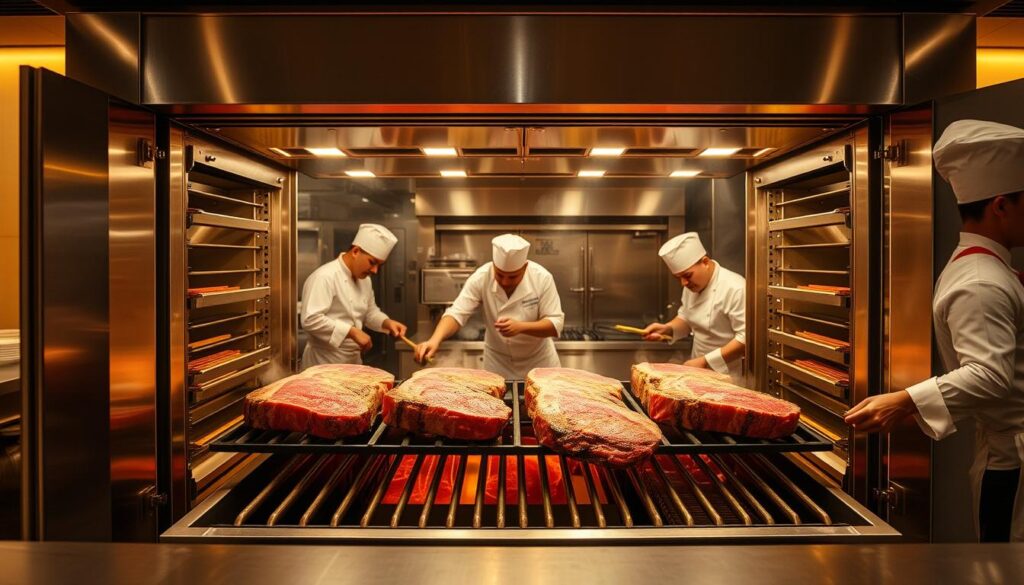
Adjusting Cooking Times and Temperatures
Sheet pans are your secret weapon for cooking many steaks at once. Make sure to leave 2 inches of space between each steak. This helps air move around and cooks them evenly.
For six steaks that are 1.5 inches thick, here’s what you need to know:
| Doneness Level | Oven Temp | Total Time |
|---|---|---|
| Medium-Rare | 400°F | 18-22 minutes |
| Medium | 425°F | 20-24 minutes |
Use a digital meat thermometer to check the steaks. This is important, as ovens can have hot spots. If your oven does, turn the pans halfway through. Keep the steaks warm in a drawer or a low oven while others finish cooking.
Serving Suggestions for Larger Parties
Before serving, slice the steaks against the grain. Then, arrange them on a platter with fresh herbs. This makes serving easy and looks great.
Here are some sides that are perfect for big groups:
- Garlic mashed potatoes in a slow cooker
- Roasted asparagus spears on sheet pans
- Individual cast-iron mac and cheese dishes
Set up a topping bar with horseradish cream, compound butters, and red wine jus. This lets everyone add their favorite flavors. For wine, choose bold Cabernet Sauvignon or Zinfandel. These pair well with the rich taste of beef.
Conclusion: Mastering the NY Strip in Your Oven
Learning to cook a New York Strip is all about trust. You’ve discovered how oven cooking ensures even heat for tender meat. Tools like meat thermometers help you get it just right. This method works for both thick cuts and quick stovetop cooking.
Embracing Your Culinary Skills
Don’t be afraid to try new things. Experiment with different seasonings or reverse-sear techniques. Add garlic butter or red wine reductions to your NY Strip for extra flavor. Each attempt helps you get better at controlling the meat’s doneness and texture.
Final Thoughts on Perfecting the Recipe
Consistency comes from following the basics. Make sure to preheat the oven, check the meat’s internal temperature, and let it rest. Once you’re comfortable with these steps, you can try more advanced techniques like dry-aging or herb-crusting. For stovetop cooking, remember to use the same temperature control as in the oven.
Share your cooking successes with friends or keep a cooking journal. Every steak you cook improves your skills, whether you’re cooking for others or yourself. Your oven-baked NY Strip is now a testament to your growing culinary expertise.
FAQ
What’s the ideal thickness for cooking New York strip steak in the oven?
Can I use the reverse sear method for New York strip steak?
What oven temperature is best for cooking New York strip steak?
How do I prevent overcooking my New York strip in the oven?
Do I need to marinate a New York strip steak?
What’s the best way to reheat leftover New York strip without drying it out?
How long should I let my New York strip rest after cooking?
What wine pairs best with oven-cooked New York strip?
Can I cook multiple New York strip steaks at once in the oven?
What’s the best pan for transitioning from stovetop to oven?
How do I identify a high-quality New York strip at the grocery store?
What’s a quick side dish to serve with oven-cooked New York strip?
Should I season my New York strip before or after cooking?
How do I fix an undercooked New York strip after slicing?
Can I use a convection oven for cooking New York strip steak?
For more cooking tips, stay connected with us. We also recommend the cookbook Skinnytaste Simple: Easy, Healthy Recipes with 7 Ingredients or Fewer
For more Recipes about Steak ?
Did You try our recipe ?
There are no reviews yet. Be the first one to write one.
